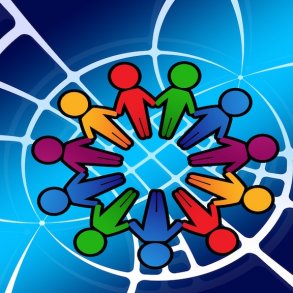By Peggy Holman and originally published at axiomnews.com
Part One republished by Enlivening Edge Magazine here.
Truth as a pathway to understanding
With good reason, journalists place a high value on truth. Yet, in an era when whom and what to trust are often an issue, truth, while necessary, is not sufficient. Truth, a commitment to clarity and accuracy, can look different through various frames of reference. When community well-being is central, truth is put in service to understanding. By drawing from multiple perspectives and examining interconnections in a complex world, journalism can eschew simple truths to tell more nuanced and meaningful stories.
I celebrated when this idea was poignantly expressed by the Mayor of Charlottesville in an editorial following the aftermath of domestic terrorism:
Democracy, like a muscle, needs to be worked out. But it’s not mere stimulus and response. We now have to make the right choices. What does this mean, practically?
Among his suggestions, it means that news organizations must redouble their efforts not only to convey correct facts, but to present the contextual and fact-checking resources that readers need to understand what’s happening.
The ethics of engaged journalism
When I listen to journalists talk about engagement, their biggest fear is that they’ll be perceived as advocates, something that is anathema for people trained to bring an objective stance to their work. I think this is the biggest shift in mindset for journalists to confront in order to provide the journalism that communities need today.
| “Stories that model and promote dialogue foster understanding, uncover possibilities, and inspire engagement.” | |
An unintended consequence of objectivity is a distancing so great that some communities find the stories out of touch with their needs, leaving them feeling unseen or misunderstood. I believe that this attitude, not new technologies, is the root of the news media’s disappearing audience.
As my colleague, Mike Fancher, retired executive editor of The Seattle Times puts it, “Journalism must be independent of any vested interest other than the public interest. It must also develop trusting relationships and the capacity for connectedness if it is to be relevant and accountable in an interdependent world.”
Ironically, during emergencies, journalists set aside their fears and put their talents to work on behalf of communities. In the aftermath of Hurricane Harvey, the Houston Chronicle has opened its paywall and provided hard copy papers to shelters. Some stories are personal, many are inspiring, with pictures and descriptions of people helping each other, providing information on where they can get help and what people need.
Change their minds about the essential purpose they serve and journalists – in partnership with community connectors – have the potential to be pivotal in turning us from a divided country to one that can hold multiple perspectives. One way to help this shift is to move from “debate” to “dialogue” as our default mode of discourse. The win/lose dynamics of debate demand that we advocate for our “side”. The exploratory dynamics of dialogue lead us to inquire, to seek to understand, to make connections, and to draw from many different perspectives to discover breakthroughs that none could have realized on their own.
Stories that model and promote dialogue foster understanding, uncover possibilities, and inspire engagement, something that is often lost when focused only on conflict and advocacy. In Washington state, where the debate on education has made it to the state Supreme Court, dialogue inspired a group diverse in political perspective, race, socioeconomics, and age to realize that they could work together for an education system in which everyone felt they belonged. Along the way, a journalist who participated in the project was inspired to offer a possible solution to the shortage of black, male teachers, an issue raised during the effort: tap underemployed immigrant teachers. This was inclusive, engaged, generative journalism on behalf of community in action.
What can you do?
If you’re not sure where to begin, I offer some ideas:
- Seek out journalists and news organizations that are doing good work. Hearken and Solutions Journalism Network provide names of organizations they support.
- When you find journalists and news organizations that are listening and doing good work, support them. Let them know. Subscribe. Reinforce good behavior. Tell family, friends, and groups that you are in
- If you have a story to tell, do so. Whether text, audio, video, or other media, provide content for a news outlet, your own blog, or social media. The Medium platform supports social connections, enabling anyone to build a following. If writing isn’t for you, find media that cover places and issues that matter to you and jump in.
- Use social media – like Twitter, Instagram, and Facebook – to discuss stories with friends and strangers, or to share what you learn about using social media. Comment on stories that move you. Organize around them. In other words, make media, share it, and use it.
- Learn about hosting conversations. The National Coalition for Dialogue and Deliberation, Art of Hosting, and Living Room Conversations are great resources for practicing civil discourse with people across the aisle.
- Invite diversity. We spend so much of our time with people like ourselves! Whenever you engage with media, notice who else needs to be involved and speak up. Reach out. Support media makers who tell stories that incorporate diverse perspectives. If you wish to engage with people from a different age, race, culture, etc., go to them. Be humble. Listen. Learn. They are more likely to join with you if they see that you are interested in a respectful partnership.
Ultimately, these actions are not just about the quality of our news and information. They are about cultivating societies that are compassionate, creative, wise, and able to deal with whatever complexities come our way. Each of us has a role to play. So step in.
This article was originally published on http://AllSides.com. AllSides uses crowd-driven, patented technology to identify bias in news sources, and showcases a variety of perspectives on any given issue to help build bridges between conflicting ideas and people.
Featured Image/graphic link added by Enlivening Edge Magazine.




